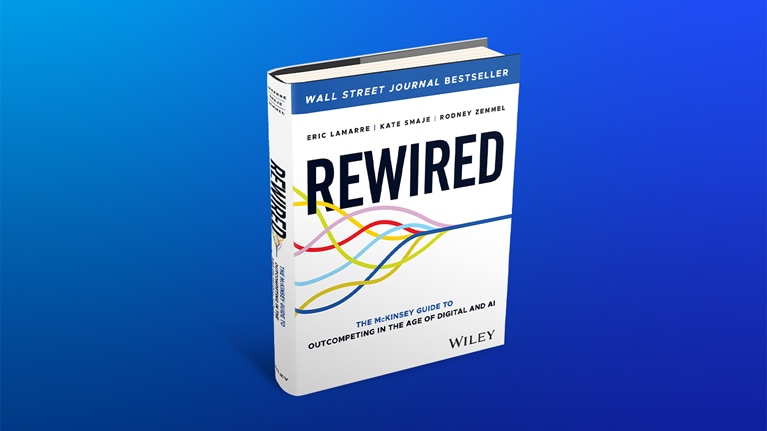Digital and AI transformations are everywhere. Almost every company has done, is doing, or plans to do one. But how can you make the changes stick? In this episode of the Inside the Strategy Room podcast, McKinsey senior partner Eric Lamarre talks about the critical elements of what it takes to rewire an organization through making fundamental changes to talent, operating model, and technology and data capabilities. He is coauthor with Kate Smaje and Rodney Zemmel of the Wall Street Journal bestseller Rewired: The McKinsey guide to outcompeting in the age of digital and AI. This is an edited transcript of their conversation. For more discussions on the strategy issues that matter, follow the series on your preferred podcast platform.
Sean Brown: What areas do you find executives struggle with the most when trying to harness technology’s potential?
Eric Lamarre: How to do it at scale. Most business leaders have had a chance to taste what technology can do. They have done successful pilots and experiments, but these are not moving the needle on company performance. This is what Rewired gets at: How do you move from pilots to large-scale implementation? It’s not really a technology problem but a talent and a data problem—how do you organize to deliver this at scale? Of course, technology is involved, but the organizational component is where the big surgery has to happen.
Sean Brown: What should be the starting point for a digital and AI transformation?
Eric Lamarre: It should always start with the business problem you want to solve. When it starts that way, there is usually a good ending because the problem eventually ties back to serving customers better and delivering more value for the company. When business leaders say, “That’s the problem I want to solve with technology,” it becomes easier to develop the technology road map to solve that problem.
Sean Brown: There is probably no bigger subject in tech now than generative AI. Are you seeing companies almost inventing problems to solve with gen AI?
Eric Lamarre: Yes. The conversations right now make it feel like a technology in search of a problem. Maybe that’s natural because when we try gen AI, it seems like a magical experience. That takes your mind to “Where else could I apply this?” It’s good to come back to the fundamentals, though—what are the pain points in the company?—then search broadly for the set of technologies that will address them. Sometimes, that will be gen AI, but that doesn’t mean gen AI is the place to start.
For example, if you’re a consumer packaged goods company, you can use gen AI in many places, but good old revenue growth management is about advanced analytics on pricing, demand, and promotions. I don’t think gen AI will do a good job on that problem, and it’s one of the top business problems for consumer goods companies. Gen AI is a bit of a super technology, but it shouldn’t take us away from the problems businesses need to solve.
The conversations [around gen AI] right now make it feel like a technology in search of a problem.
Sean Brown: One of the elements you highlight in the book as essential to long-term success in digital transformations is talent. What approach to talent do you recommend?
Eric Lamarre: In my experience, the conversation usually starts with, “All this AI stuff is wonderful, but we will never get the talent to do this.” In reality, traditional companies that are serious about digital transformations manage to get the right talent, but they have to be committed to a modern technology environment that will make it easy for employees to do their jobs. Talent wants to know that the company they join won’t cause their skills to atrophy because it’s using an old technology stack and software engineering methods. They will ask questions such as, “Tell me about your technology architecture. Tell me about how you manage data. Tell me about your software engineering method.” These questions will come very early in the conversation, and if it doesn’t sound like the company is serious, they will walk out because what they value most right now is their craft.
Sean Brown: Have you seen incumbent companies successfully develop their existing talent to manage new digital products or solutions?
Eric Lamarre: Yes. For example, a product manager might envision a solution. They will master the problem to be solved, develop the road map on how to solve it, and then guide their team to that solution. To understand the business problems, people need to have experience in the business. Usually, companies provide additional training and skills, but the most important skills are not those of a technologist but of a businessperson who understands enough about technology to imagine how it can solve the problem.
Sean Brown: What might cause a company to not capture the full value of a technology it implements?
Eric Lamarre: I’ll give you a concrete example. We developed technology for an airline to maximize the fill rate of its cargo space. It’s a highly profitable business for an airline, but maximizing that fill rate is difficult because you don’t know how many passengers will show up and how many will have suitcases, and those determine the extra space for cargo. It’s a beautiful problem for AI, and the technology we developed could say exactly how much extra cargo space there would be and what to charge for that space. But when we checked the planes, they weren’t flying with the cargo they were supposed to have. Why? The palletizing procedures at the airport were not quite right.
That is a lesson I have learned over and over: Whenever you develop a technology, there will be a secondary effect somewhere in the system that will prevent you from fully capturing the value. In this instance, the answer was to train operators at the airport on how to maximize pallet caseloads. That’s not a technology problem; that’s just a good old operational problem. Technology usually unveils a bottleneck in the process that needs to be solved to realize the technology’s value. Therein lies the importance of business leaders owning the end-to-end reimagination of the process because once they have deployed the technology, they need to play a key role in chasing down bottlenecks throughout the chain.
Sean Brown: In the book, you say, “You can’t outsource your way to success.” Can you elaborate?
Eric Lamarre: We find technology development is much more productive when done in-house. Why do I say that? If you’re a data engineer, a software engineer, or a machine-learning engineer working on a business problem, you can develop the right technology two to four times faster if you understand the context of that problem. And that doesn’t happen overnight. In-house technologists will also understand the context for the next incremental innovation on that problem and the one after that, and your whole innovation wheel starts to fly a lot faster.
Sean Brown: What role should external technologists or consultants play, then, in building an organization’s technological muscle?
Eric Lamarre: I face that question often, and my answer to clients is that they should not rely heavily on consultants. They should build that capability themselves. Developing that flywheel is not easy to start. How do you build a technologist bench? How do you show them the right way to work? How do you bring business to the dance? A third party that knows what they’re doing can accelerate this process, but you don’t want to completely outsource that capability. If you want it to become a source of competitive differentiation, you need to own it. You can’t outsource your way to competitive differentiation.
Whenever you develop a technology, there will be a secondary effect somewhere in the system that will prevent you from fully capturing the value.
Sean Brown: Does it help digital transformations succeed if business leaders try to shift employee mindsets to see the organization as a digital or tech company?
Eric Lamarre: Some companies truly embrace that. In the book, we talk about DBS Bank, an organization that viewed itself as becoming a technology company. But not every company likes that analogy. They feel their core business is not technology but mining or consumer goods, and technology is a complement, not the core. However, if technology is going to play a role in driving competitive differentiation—better-served customer, lower unit cost—the company has no choice but to become good at software development. No company would debate whether they need to be good at finance. Well, if you want to be good at running a company infused with technology, you have to be good at software development.
Sean Brown: Should businesses think of technology less as a separate department such as HR or finance and more as a fundamental aspect of the organization?
Subscribe to the Inside the Strategy Room podcast
Eric Lamarre: Yes. A central theme of our book is getting to a state I call “distributed digital innovation.” You might start with a handful of teams developing technology solutions. Their apps or models will show some value, but the rest of the company won’t be transformed. When you reach a rewired state, those few teams multiply a 100-fold and work in various parts of the organization—sales, supply chain, manufacturing, R&D. They serve the leaders of those different areas, developing technology to solve their problems. At that point, no one calls IT to develop a solution because each area has that capability. IT evolves into a distributed function with distributed technology capabilities.
Sean Brown: What role does the IT team take on in such a rewired organization?
Eric Lamarre: IT would become the bedrock enabling cybersecurity and distributing the tools and data needed for innovation. IT remains an important platform capability, but it’s no longer the sole engine of innovation. That belongs in the hands of the enterprise more broadly.
Sean Brown: How should the top executive team, including the CIO and the CFO, think about their roles in this new environment?
Eric Lamarre: Everybody around the CEO has a role to play in that transition. The CIO now needs to move to a model where they are enabling the rest of the organization to innovate securely, with access to the tools and data they need, and providing them with the development capacity that used to reside in IT. That flip is a major transformation of the IT function. For HR, the talent equation is massive. HR staff need to recruit from outside and upskill people in product management. In a large institution, tens of thousands of people may need to go through that HR transition. The head of HR also needs to figure out how to assess a data engineer on the basis of skills because skills become the currency, not how many people someone manages.
Then there is finance. How do you fund all of this? Before, when you had a big IT project, you debated it, built a business case, funded millions for the project, and mobilized a big team. Often, two years in, something would cause the project to go off the rails. That’s IT in the old days. IT in the new days gets funded differently, with many small teams. You can’t fund 500 different teams project by project; you have to move to something called persistent funding, where you are funding portfolios of small teams rather than individual projects. You continue the funding until solving the problem is no longer productive. Moving to persistent funding from project funding is a massive shift for finance.
You can’t outsource your way to competitive differentiation.
Now, think about the people who head control functions: risk management, compliance, and regulation. Now, they have 500 little teams innovating, so they are underwriting new risk. The role of the control functions needs to move upstream to guide that development. They need to ask before development has even begun, “Are there any risks these teams are undertaking that we should be monitoring?” If a team is working with customer data, there are data privacy risks, and you don’t want to tell the team six months into the project, “You didn’t handle data privacy, so we can’t use the work you did up to now.” These functions also need processes to monitor that the risks have been addressed.
Long story short, when you move to a distributed innovation model, everybody in the C-suite has a new job. Everybody has to drive a transformation of their area for the whole system to work. It becomes what we call in the book “the ultimate corporate sport,” and everybody’s got to play.
Sean Brown: Many executives fear the complexity of IT—you tug on one wire, and 14 things fall apart. How would you ease those concerns?
Eric Lamarre: It’s the main reason why we wrote this book. The technology field has become very complex. Take gen AI—executives are wondering, “Does it mean old AI is dead, and now I just focus on gen AI? By the way, I keep hearing about data engineers—what do they do? And data architecture, I don’t understand any of that. How does that work? And I’ve been hearing about agile for ten years. Is that still relevant?” I could go on and on. The lack of a common understanding around the executive table makes progress very difficult because it’s become a world of buzzwords.
To some extent, we wrote this book to “de-complexify” the space and focus on what matters to getting value from new technology. Typically, when an executive starts on this journey, I counsel them, “Go slow to go fast.” Take your team on a shared learning journey. Invest 10 or 15 hours to establish a common language and base of technology understanding, clarifying all the questions I just mentioned and others. Second, visit companies that are further ahead in such transformations. Get inspired by what their leaders achieved and build your own confidence that you can do it, too. After that investment—and it’s not such a big investment—the alignment is there, and the top team can start to play their respective roles in leading the technology transformation.


